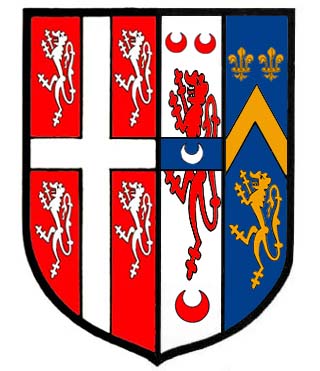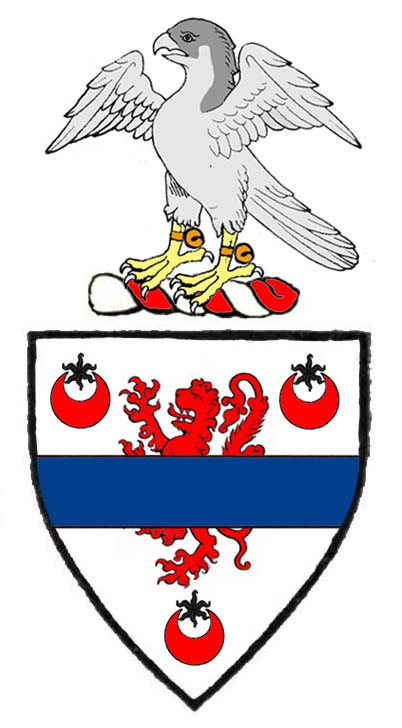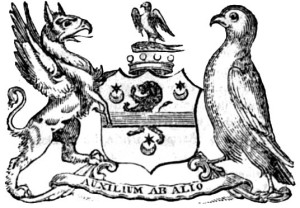© Donal G. Burke 2013
The Dillons are an Anglo-Norman family who acquired estates about the later counties of Longford and Westmeath and environs in the medieval period and a senior line of who were established at Drumraney in Westmeath in that same medieval period.[i]
Gerald Dillon of this family was Lord of Drumraney about the late fourteenth century and by his wife Emilia Fitzgerald of Desmond had four sons. From Sir Maurice Dillon, the eldest son derived the later line of the Viscounts Dillon of Costello-Gallen.[ii] From Gerald’s third son, Sir James, would eventually descend the two separate branches of the Earls of Roscommon and the Dillons of Clonbrock in east Galway.
Sir James Dillon, third son of Gerald Dillon of Drumraney, was reared in England and acquired a large estate about Tara in Meath. He was attributed with the construction of a mansion house on his lands at Proudstown and a castle and parochial church at his manor of Skreene. His son Sir Robert Dillon married a daughter of Sir James Bermingham and inherited the Proudstown and Skreen estates. He had five sons; Sir Richard, his heir, Gerald, Sir James, Walter, Henry and two daughters Anne and Ellinor.[iii]
The family of Dillon of Clonbrock in the parish of Fohenagh in east Galway derive their descent, through Gerald, younger brother of Sir Richard Dillon of Proudstown and Riverston and second son of this Sir Robert Dillon of Proudstown and Skreene.[iv]
From Gerald’s elder brother Sir Richard descended the Dillon Earls of Roscommon, while Gerald married Elizabeth, daughter of John Lord Barry and had four sons and three daughters; Richard, Gerald, Robert, James, Ellice, Mary and another daughter.
The first of Clonbrock, County Galway
This Richard, eldest son of Gerald, was succeeded by his son Thomas, a lawyer who served as a Commissioner of the province of Connacht in 1576, was appointed Chamberlain of the Exchequer and Clerk of the Crown and Sessions in the counties of Meath, Westmeath, Drogheda, Louth and Longford. He was appointed Judge Itinerant of the province of Connacht and settled at Clonbrock about the late sixteenth century, purchasing a large estate thereabout.[v]
Thomas married a daughter of one surnamed Allen of Palmerston, by whom he had a son Thomas of Clonbrock and Curraghboy in the County of Roscommon who in 1603 was appointed Chief Justice of Connacht. This latter Thomas married Elice, sister of Sir Francis Shaen or Shane and had by her two sons; Thomas and Robert and at least one daughter, Jennett. The elder of his two sons was killed when the castle of Curraghboy was assaulted by the Burkes and Keoghs and being unmarried, the paternal estate passed to his younger brother Robert, who was aged twenty nine years when he succeeded his father on his death in 1606.[vi]
The arms of Thomas Dillon ‘Chiefe Justice of Connach,’ who died on the 18th September 1606 and was buried in Dublin, after those exemplified in his Funeral Entry in the records of the Ulster King of Arms. His wife was given therein as ‘Elice, sister to Sir Frances Shaen, knight’ with the arms of Shaen shown on the sinister side of the impaled arms. Those of Dillon were shown with a fess Sable rather than Azure. (N.L.I. Dublin, G.O. Ms. 66 Funeral Entries 1604-1622, p.4.)
Although the arms of Thomas Dillon were shown in his Funeral Entry with a fess Sable, when his son-in-law John Bath of Drumcondra in County Dublin died in 1634, the latter’s arms were shown tricked in the records of the Ulster King of Arms and gave the Bath arms impaled with the paternal arms of Bath’s two wives. Those of his first wife, Jennett, daughter of Thomas Dillon, Chief Justice of Connacht, were shown with a crescent Argent on a fess Azure and the lion rampant and three crescents were all tricked Gules, but without the estoiles.
The arms of John Bath of Drumcondra, County Dublin, who died in 1634, showing on the sinister side the paternal arms of his first wife, Jennett, daughter of Thomas Dillon, Chief Justice of Connacht and those of his second wife Barbara, daughter of Patrick Gough of Dublin, Alderman and sometime Mayor and widow of William Gough of Dublin. (N.L.I. Dublin, G.O. Ms. 79 Funeral Entries c.1619-1729, p.38.)
Robert Dillon of Clonbrock married Catherine Hussey of Mulhussey and had nine sons and four daughters; Richard, his heir, Lucas, Bartholomew, James, Thomas, Gerald, Edward, another Bartholomew, Christopher, Jane, Mary (who married Sir John Bellew of Willistown), Ellice and Catherine. He died in December 1628 and was buried in the church of ‘Kilclowne.’[vii]
Seventeenth Century
One of the earliest arms specifically associated with a member of the immediate family of Clonbrock appears on an armorial stone above the doorway to a chapel in Barmeath in County Louth.
Sir John Bellew of Willistown in County Louth married Mary, daughter of Robert Dillon of Clonbrock in the mid seventeenth century. He had been exempted from pardon for life by the Cromwellians and transplanted to Galway and in 1682, under the Act of Settlement that was enacted following the restoration of the monarchy; he received a grant of lands in Counties Louth and Galway. From an elder son derived the Bellews of Barmeath, County Louth, while from a younger derived the Bellews of Mount Bellew in east Galway.[viii]
The lands and manors granted in 1682 to Sir John Bellew under the Act of Settlement included the former estate of the Moore family of Barmeath in County Louth. John Bellew died in 1679 and the construction of the chapel was attributed to his widow Mary in a commemorative armorial stone inserted over the doorway.
The stone displayed the impaled arms of her husband John Bellew of Williamstown, combining the arms of Bellew and Dillon.[ix] No tinctures were later evident but the Bellew arms displayed on the dexter half of the shield was that of a simple fretty pattern, suggesting the Sable fretty Or borne by later members of the family. On the sinister half the Dillon arms were composed of a crudely carved lion rampant debruised by a fess, with one distinct crescent with a mullet of five points between its horns and what appears to have been a second in chief and another in base.[x] (If a second crescent was originally carved in chief it became significantly eroded in time.) The mullet between the crescent in base, however, appears to have been of six points and may have been intended as an estoile. On the fess of the Dillon arms was carved a mullet. It has been suggested that the mullet as a mark of cadency indicating a third son was a reference to the descent of the Dillons of Clonbrock from Sir James, third son of Gerald Dillon of Drumraney.[xi] This mullet, however, did not continue on all arms of those of the family of Clonbrock.
The impaled shield was surmounted by a closed visored helmet in profile, atop of which, on a wreath, was carved an arm embowed for crest. The crest became eroded over time and may originally have been armoured and held a sword as in other examples of Bellew arms. From the helmet issued mantling cascading either side of shield in late seventeenth century style.
The origin of the Falcon crest and fess Azure
The crest associated with the Dillons of Clonbrock was reputed to have had its origin in a grant to Sir Richard Dillon, eldest son of Sir Robert of Proudstown and Skreene, of the more senior line. This Sir Richard was said to have brought six hundred soldiers from Ireland to the battle of Verneuil, fought in Normandy in August 1424. Following the English victory over the French the Duke of Bedford, Regent of France for the infant King Henry VI of England, rewarded Sir Richard for his service by making him a knight banneret and granting him ‘a falcon volant’ for his crest in place of the ‘demi-lion’ he was said to have formerly borne and augmenting his shield with a ‘fess Azure’ over the lion rampant of his former arms.[xii] It was later claimed that this fess was an allusion to a belt or girdle of honour worn by contemporary commanders in the field of battle.
This Sir Richard married Jeane Wile of Riverston, thus acquiring that estate to add to his paternal estate of Proudstown.[xiii] The line of Proudstown and Riverstown, from whom descended the Dillon Earls of Roscommon were a distinct and more senior line to that of Clonbrock and Curraghboy, the former descending from that Sir Richard who fought at Verneuil and the latter from his younger brother Gerald. The latter line, however, also came to bear the same crest and the fess reputedly added as an augmentation to the senior line’s arms. If the tradition relating to the origin of the falcon and fess was correct, the Clonbrock line bore elements in its arms originally earned by the ancestor of the other more senior line.
Baron Clonbrock of Clonbrock
Robert, eldest son of Luke Dillon of Clonbrock by his wife Bridget, daughter of John Kelly of Castlekelly, County Galway, was raised to the peerage of Ireland by the title of Baron Clonbrock in 1790.[xiv]
Robert Dillon, 3rd Baron Clonbrock of Clonbrock in the County of Galway in the peerage of Ireland, born in 1807, bore for arms ‘Argent, a lion rampant Gules debruised with a fess Azure between three crescents of the second, with estoiles between the horns Sable.’ For crest he bore, upon a chapeau Gules turned up Ermine, a falcon rising Proper, belled Or. For dexter supporter he carried a griffin and for sinister, a falcon, wings endorsed. For motto he bore on a scroll ‘Auxilium ab alto.’[xv]
Arms of Luke, 2nd Baron Clonbrock of Clonbrock (from ‘a Biographical Peerage of Ireland,’ dated 1817.)
Viscount Dillon of Costello-Gallen
The arms of Charles Dillon-Lee, 12th Viscount Dillon of Costello-Gallen, born in 1745, was given as ‘quarterly first and fourth; Argent, a lion passant between three crescents Gules (for Dillon), second and third, Argent, a fess between three crescents Sable (for Lee). For crest he bore a demi-lion Gules holding between his paws an estoile Argent. For supporters he bore ‘two angels Proper vested Argent with wings elevated, the dexter having a sash over her shoulder Azure, each holding in her dexter hand a palm branch Proper. For motto he carried ‘Dum Spiro Spero.’[xvi]
The line of the Viscounts Dillon of Costello-Gallen was more senior again than those of the Earls of Roscommon or that of Clonbrock and the title had been created for Sir Theobald Dillon of Costello-Gallen, who had been knighted on the field of battle in 1559 and raised to the peerage in 1621 or 1622.
Ballynakill Church, Glinsk
The arms of this branch of the Dillons appears in north east Galway on a large memorial tablet erected at Ballynakill church about 1722. The tablet was placed in a position of prominence beside that of the relocated effigy of a medieval knight on the east gable of the church, the east window being blocked to facilitate the memorial to the early eighteenth century head of the MacDavid Burke family of Glinsk.
Sir John Burke of Glinsk, 4th Baronet married Jane, daughter of Theobald, 7th Viscount Dillon of Costello-Gallen and died between 1721 and 1724.[xvii] Sir John Burke’s impaled arms were carved atop the Ballynakill tablet, with the arms of that branch of the Burkes on the dexter side shown as a simple cross with a lion rampant in the top dexter canton carrying the dexter hand badge of a baronet at centre-point. The Dillon arms of his wife’s family were displayed on the sinister side of the shield as a lion rampant between three crescents, two in chief and one in base. Above the helmet the crest of this branch of the Burkes gave a plume of feathers emanating from a coronet and their motto below as ‘Sola salus servire Deo.’
Being descended from a distinct branch of the wider family to the descendants of that Sir Richard whose arms were reputedly augmented at Verneuil, the Viscounts Dillon of Costello-Gallen did not bear the fess used by others of the name, and bore the demi-lion that according to tradition pre-dated the falcon crest used by other branches. They likewise did not bear the estoiles or mullets found between the horns of the crescents in the arms of Roscommon and Clonbrock. The family of Costello-Gallen were frequently given as bearing a lion passant as opposed to a lion rampant as the principal charge on their shield but the impaled arms in Ballynakill gives the lion as rampant.
[i] Lodge, J., Archdall, M, The Peerage of Ireland, or, a genealogical history of the present nobility of that kingdom, with engravings of their paternal coats of arms, James Moore, Dublin, 1789, Vol. IV, pp. 135-7.
[ii] Lodge, J., Archdall, M, The Peerage of Ireland, or, a genealogical history of the present nobility of that kingdom, with engravings of their paternal coats of arms, James Moore, Dublin, 1789, Vol. IV, pp. 138-9.
[iii] Lodge, J., Archdall, M, The Peerage of Ireland, or, a genealogical history of the present nobility of that kingdom, with engravings of their paternal coats of arms, James Moore, Dublin, 1789, Vol. IV, pp. 138-9.
[iv] Lodge, J., Archdall, M, The Peerage of Ireland, or, a genealogical history of the present nobility of that kingdom, with engravings of their paternal coats of arms, James Moore, Dublin, 1789, Vol. IV, pp. 138-9.
[v] Lodge, J., Archdall, M, The Peerage of Ireland, or, a genealogical history of the present nobility of that kingdom, with engravings of their paternal coats of arms, James Moore, Dublin, 1789, Vol. IV, pp. 138-9.
[vi] Lodge, J., Archdall, M, The Peerage of Ireland, or, a genealogical history of the present nobility of that kingdom, with engravings of their paternal coats of arms, James Moore, Dublin, 1789, Vol. IV, pp. 138-9; N.L.I. Dublin, G.O. Ms. 66 Funeral Entries 1604-1622, p.4; N.L.I. Dublin, G.O. Ms. 79 Funeral Entries c.1619-1729, p.38. Lodge gives Elline sister of Sir James Shane as wife of that Thomas Dillon, Chief Justice of Connacht who died in 1606.
[vii] Lodge, J., Archdall, M, The Peerage of Ireland, or, a genealogical history of the present nobility of that kingdom, with engravings of their paternal coats of arms, James Moore, Dublin, 1789, Vol. IV, pp. 138-9.
[viii] Bellew, S., Coats of Arms and the Bellew Family, Journal of the County Louth Archaeological and Historical Society, Vol. 25, No. 4, 2004, p. 434.
[ix] Bellew, S., Coats of Arms and the Bellew Family, Journal of the County Louth Archaeological and Historical Society, Vol. 25, No. 4, 2004, pp. 427, 441, Plate 5, d.
[x] Bellew, S., Coats of Arms and the Bellew Family, Journal of the County Louth Archaeological and Historical Society, Vol. 25, No. 4, 2004, p. 441, Plate 5, d.
[xi] Bellew, S., Coats of Arms and the Bellew Family, Journal of the County Louth Archaeological and Historical Society, Vol. 25, No. 4, 2004, p. 435.
[xii] Lodge, J., Archdall, M, The Peerage of Ireland, or, a genealogical history of the present nobility of that kingdom, with engravings of their paternal coats of arms, James Moore, Dublin, 1789, Vol. IV, p. 140.
[xiii] Lodge, J., Archdall, M, The Peerage of Ireland, or, a genealogical history of the present nobility of that kingdom, with engravings of their paternal coats of arms, James Moore, Dublin, 1789, Vol. IV, p. 140.
[xiv] A Biographical Peerage of Ireland, London, J. Nichols and Co., etc., 1817, pp. 369-370.
[xv] Burke, J., A General and Heraldic Dictionary of the Peerage and Baronetage of the British Empire, Fourth Edition, Vol. I, London, Henry Colburn and Richard Bentley, 1832, p. 266.
[xvi] Lodge, J., Archdall, M, The Peerage of Ireland, or, a genealogical history of the present nobility of that kingdom, with engravings of their paternal coats of arms, James Moore, Dublin, 1789, Vol. IV, pp. 200-1.
[xvii] Lodge, J., Archdall, M, The Peerage of Ireland, or, a genealogical history of the present nobility of that kingdom, with engravings of their paternal coats of arms, James Moore, Dublin, 1789, Vol. IV, p. 194. He is given in this source as Sir John Bourke of Mitford, Bart.






